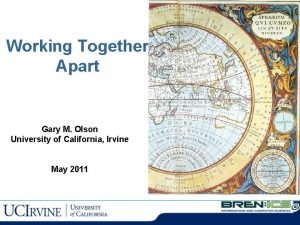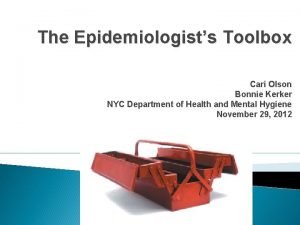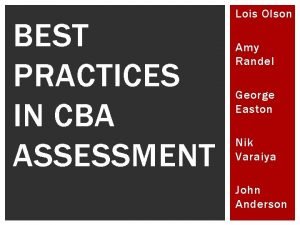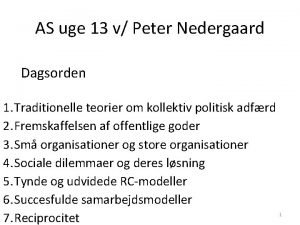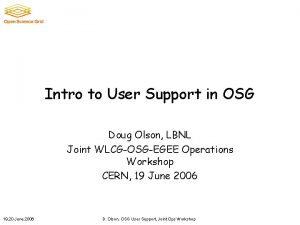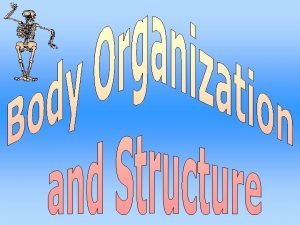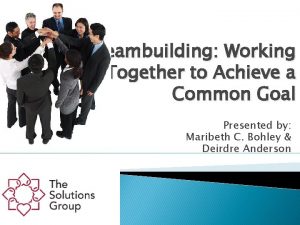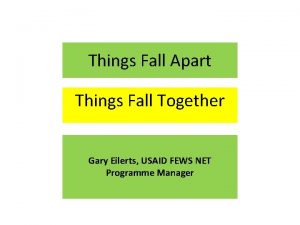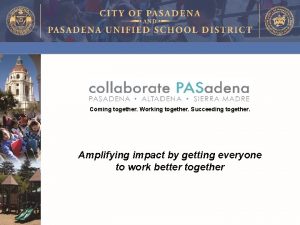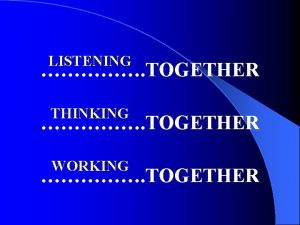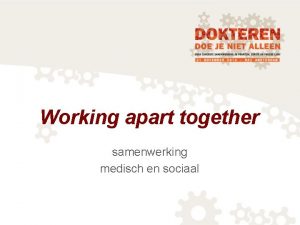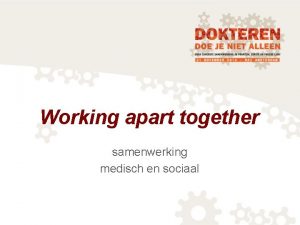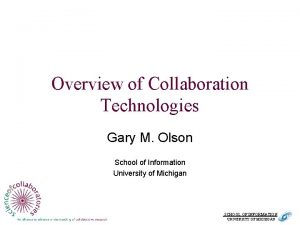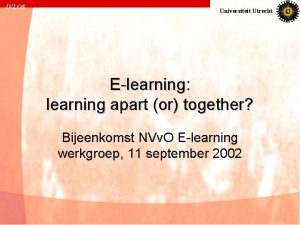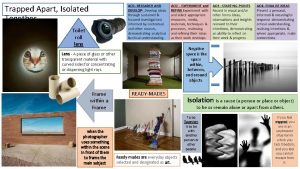Working Together Apart Gary M Olson University of


































- Slides: 34

Working Together Apart Gary M. Olson University of California, Irvine May 2011

This work… n …is done by • • • n Judy Olson Gary Olson Steve Abrams Matthew Bietz Julia Haines …and supported by • • Army Research Institute National Science Foundation Google Donald Bren Foundation


Distance n T. Allen, 1977 30 meters

“Distance Matters” -- Some Overarching Issues n n n n Ease of communication -- common ground Nature of the work -- How tight the coupling Readiness to collaborate Technology readiness -- personal, infrastructure Trust Culture Time Zones

The first concept n The longer the distance between people, the less common ground they have – Definition: what is assumed to be shared between two people who are communicating – If you don’t have natural common ground, you have to work at it, discover what each other knows in common and build from there.

Second key concept n n Tightly coupled work requires collocation Work gets reorganized so that tightly coupled is in one location, loosely coupled crosses locations

Coupling, continued n Coupling -- extent of dependence between team members, and the ambiguity of the work, requiring high degree of interaction – loose • an overall plan divides the work, occasional coordination checks (e. g. , large scale routine design) – moderate • more spontaneous divide and conquer – tight • high mutual dependence for advancing the work (e. g. , early planning of a project)

Third Key Concept n n n Collaboration readiness The community has to have a spirit of collaboration. Motivation to work together: – – – Mix of skills Greater productivity Like working together Something in it for everyone NOT • Mandate from the funder • The only way to get the money • Asymmetries in value, etc.

Collaboration Readiness (Cont. ) n Trust – Reliable – Produce high quality work – Have their best interests at heart n n Goals aligned Group self-efficacy

Fourth key concept n n n n n Different organizations are at different developmental stages in using technology of all sorts Collaboration Technology Readiness (both individual & infrastructure) email attachments using repositories calendaring creating repositories hand-off collaboration synchronous collaboration Need training in technologies AND how to collaborate

Fifth key concept n n Added in J. Olson et al, 2008 Distance work requires good management and decision making principles – Cummings & Kiesler (2005) studied NSF KDI collaborations • Collocated more successful than distributed • Distributed success associated with good mnagement

Management, Planning, and Decision Making n n Management plan Project manager is respected and has project management experience Communication plan Plan has room for reflection and redirection

Management, Planning, and Decision Making n n No legal issues remain No financial issues remain Knowledge management system Decision making is – Free of favoritism – Fair and open – Everyone has opportunity to influence

MIT Press, 2008

“Distance Matters” a decade on n Have things changed? n Much has happened in a decade – A large amount of research on the issues most relevant to distance work – An array of new or improved technologies – Big changes in the experience base of those who might work at a distance

Distance Work will Only Increase n 67% of companies anticipate increased reliance on virtual teams – 80% for companies with 10, 000+ employees n n 35% of respondents rated difficulty of management as top challenge for virtual teams 92% said trust is critical for virtual teams • Survey by Institute for Corporate Productivity

Survey of “Hopeful Signs” n Research or technology developments that might ameliorate some of these challenges n Not all of these are yet backed up with careful evaluation

Common Ground n Routinization of knowledge management – Creative incentive schemes n Awareness support – – Social computing, sharing IM, awareness tools Audio, video options Social proxies

Common Ground n Workers who are always on line – More mobile options

Nature of the Work n Increased realization of need for divide and conquer n Use of face-to-face meetings to kick of a project – Organize the work

Collaboration Readiness n Better understanding of the role of incentives – Explicit contracts with financial incentives n Importance of trust – Interventions to establish & maintain

Collaboration Technology Readiness n Many new widely used technologies – Increased sophistication n Wider array of back channels – IM, SMS, mobile phones

Collaboration Technology Readiness n Technologies better designed – Easy to use – Reliable

Management and Decision Making n Boom market on books, articles on how to manage virtual teams n Recognition of leadership skills for virtual teams

Trust n Promising results on establishing & maintaining trust at a distance – Informal social interaction a key n Better support for awareness, presence – Overcome attribution errors

Culture n More awareness of the nature of cultural differences – E. g. , increased sales of Culture Shock books – New university programs n Job rotation in multinational companies

Time Zones n n n Adjusting work hours Routines for shift changes Exploration of asynchronous awareness tools


Early Progress in Climbing Himalayan Giants n First 8000 meter peak climbed in 1950 – Annapurna n n Everest (8850 meters) first climbed in 1953 Other 12 8000 meter peaks climbed between 1953 and 1964

Characteristics of Early Climbs n Huge logistical support required – Long ascents with numerous camps – Long preparation period n Large climbing parties – Up to a score of climbers – Hundreds of supporters n n n Dominant use of oxygen Climbs confined to spring, early summer Many failures, including fatalities

Since the 1950 s n n n Exploration of many new routes, many that were thought to be “unclimbable” Small parties with rapid ascents Solo ascents Ascents with no oxygen Hundreds of ascents in a given season Still dangerous

What Changed? n Better knowledge of the Himalaya – Maps, aerial surveys – Weather n More experience with climbing – New techniques – Better understanding of physiology n n New, improved equipment But, still very difficult

Analogous to Distance Matters n More knowledge, experience – Organizations – Individuals n Better tools n But still difficult
 Gary m olson
Gary m olson Slides
Slides Thumbs up elbows back knees apart
Thumbs up elbows back knees apart Zoe ann olson
Zoe ann olson Toolbox nyc
Toolbox nyc Modelo olson
Modelo olson Kyler olson
Kyler olson Dr michael olson
Dr michael olson Lois olson sdsu
Lois olson sdsu Macur olson
Macur olson Corinne olson
Corinne olson Mancur olson
Mancur olson Lynn olson intel
Lynn olson intel Morenet internet
Morenet internet Zach olson md
Zach olson md Mancur olson
Mancur olson Olson
Olson Doug olson cms
Doug olson cms Pam olson pwc
Pam olson pwc Dialogic practice definition
Dialogic practice definition Smart vs hard working
Smart vs hard working Cold working processes
Cold working processes Hot working and cold working difference
Hot working and cold working difference Differentiate between hot working and cold working
Differentiate between hot working and cold working Pembentukan logam
Pembentukan logam Working together to safeguard children 2020
Working together to safeguard children 2020 Teamwork animals working together
Teamwork animals working together Udai working together works
Udai working together works Teamwork poem summary
Teamwork poem summary A group of similar cells working together.
A group of similar cells working together. Tissues are groups of similar cells working together to
Tissues are groups of similar cells working together to Working together to achieve a common goal
Working together to achieve a common goal Circulatory and respiratory system working together
Circulatory and respiratory system working together Working together with parents network
Working together with parents network Teamwork
Teamwork
